ECONOMIC OUTLOOK AND INDICATORS IN GEORGIA
HOTEL PRICE INDEX
PMC RESEARCH - IFO GEORGIAN ECONOMIC CLIMATE
BLACK SEA BULLETIN
QUARTERLY TOURISM UPDATE
ECONOMIC OUTLOOK AND INDICATORS IN UKRAINE
SECTOR SNAPSHOTS
EMPLOYMENT TRACKER
MACRO OVERVIEW
BAG Index
Profile Of Bilateral Relations
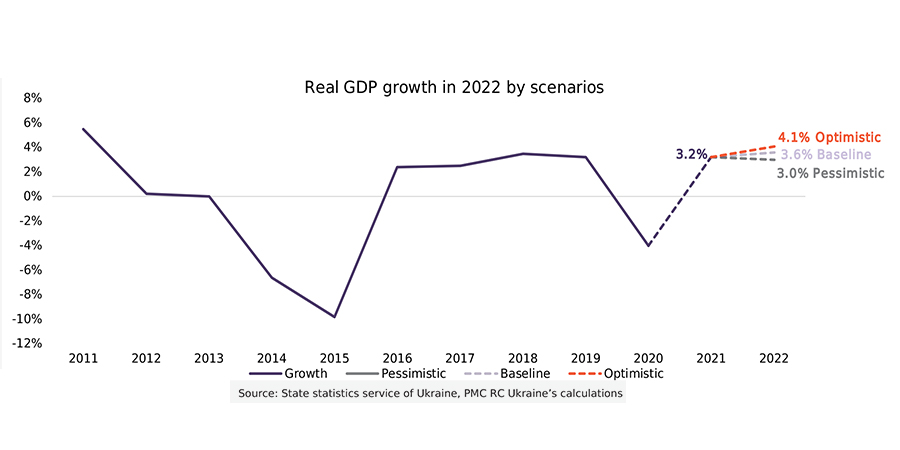
Issue 14: Economic Growth Forecasts in Ukraine: 2022
14-Jan-2022
Nearly two years since the outbreak of COVID-19, the spread of the virus itself, vaccination rates, and new variants, continue to shape the speed and strength of economic recovery. In the case of Ukraine, geopolitical and domestic political tensions are also important variables to have been hindering economic growth. In this issue, we provide an overview of the ongoing economic recovery in Ukraine and try to supply an economic forecast for the country for 2022, looking at the performance of each economic sector in the process.
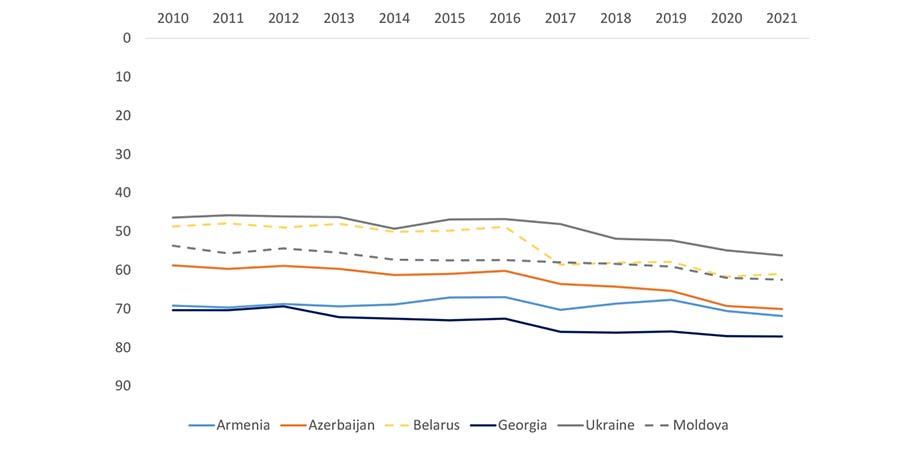
Issue 13: Ukraine in International Rankings
21-Dec-2021
International rankings and indicators help us to understand and assess how countries are performing in different areas. In this bulletin, Ukraine’s positions in international rankings and the dynamics therein are reviewed based on recent data. Its positions will also be compared with other Eastern Partnership (EaP) countries (Armenia, Azerbaijan, Belarus, Georgia, and Moldova).
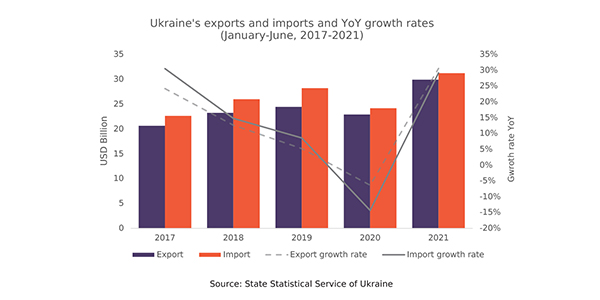
Issue 12: Ukraine’s External Trade (January-June, 2017-2021)
04-Oct-2021
Total trade turnover in Ukraine amounted to 61.2 bln USD, marking an increase of 14.07 bln USD (29.9%) compared to the corresponding period of 2020;
Ukrainian exports increased by 7.01 bln USD (30.6%) compared to the corresponding period of 2020, while Ukrainian imports increased by 7.06 bln USD (29.2%);
Compared to the corresponding prepandemic period of 2019, Ukrainian exports increased by 5.5 bln USD (22.3%), while its imports increased by 3.01 bln USD (10.7%);
Ukraine’s trade deficit amounted to 1.3 bln USD, which represents a 0.02 bln USD (1.5%) decrease compared to the corresponding period of 2020;
Ukraine’s main trade partners were China, Poland, and Germany, with shares in total trade volume of 14.5%, 7.6% and 6.5%, respectively. Ukraine’s main export partners were China (14.3% of total exports), Poland (7.9%), and Turkey (6%). Meanwhile, its main import partners were China (14.6% of total imports), Germany (8.9%), and Russia (9.1%);
54.4% of Ukrainian exports were concentrated among its top ten partners, while imports were slightly less diversified with the top ten partners responsible for 63.7% of total imports;
Compared with the corresponding period of 2020, a 24.3% decrease in trade turnover with Russia was observed, while significant 33% and 40.6% increases were recorded in the cases of China and the EU.
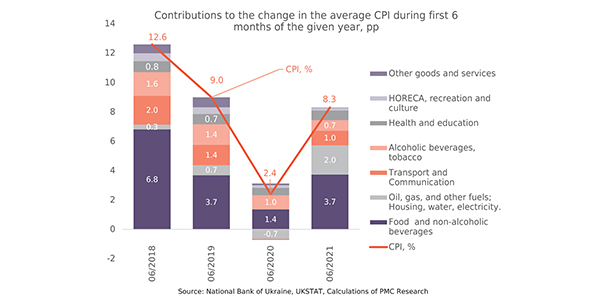
Issue 11: Inflation Trends in Ukraine
13-Sep-2021
The COVID-19 pandemic continues to represent a major economic shock, causing considerable inflation volatility. The pandemic has been responsible for a substantial decline in inflation rates over the course of 2020 globally. However, this trend underwent a significant reversal in the first half of 2021. In this issue, we overview inflation trends in Ukraine prior to and during the COVID-19 crisis.
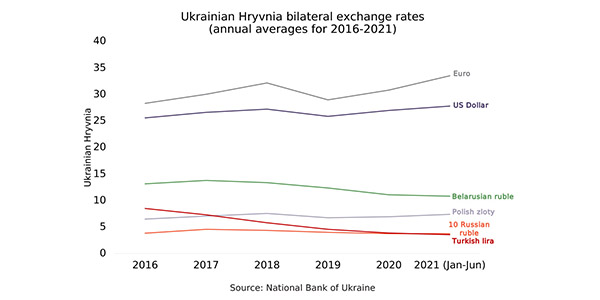
Issue 10: Exchange Rates in Ukraine (2016-2021)
12-Aug-2021
The Ukrainian Hryvnia’s exchange rates relative to foreign currencies experienced some noteworthy tendencies in 2016-2021. This period of course includes the ongoing COVID-19 pandemic, which has had a significant impact on exchange rate fluctuations globally. In this bulletin, we review the exchange rate fluctuations in Ukraine in 2016-2021, as well as some of the key factors affecting it.
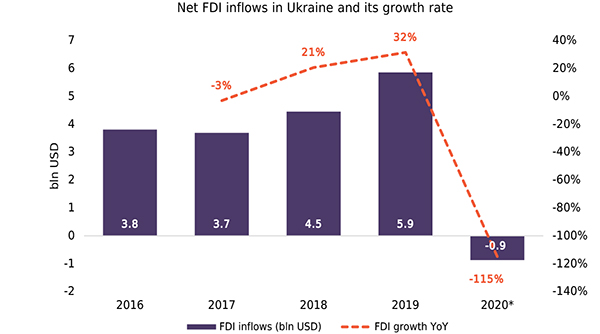
Issue 9: Foreign Direct Investments in Ukraine 2016-2020
25-Jun-2021
The COVID-19 pandemic and the subsequent Great Lockdown have affected investment flows all over the globe, especially in emerging markets. According to UNCTAD, global Foreign Direct Investment (FDI) flows dropped by 35% in 2020, to $1 trillion, from $1.5 trillion in 2019. This is almost 20% below the 2009 levels after the global financial crisis. Moreover, the number of newly announced greenfield projects in developing countries declined by 42% in 2020 compared to 2019. To assess the impact of the crisis on the FDI flows in Ukraine, it is crucial to have a snapshot of the pre-crisis situation along with developments in 2020.
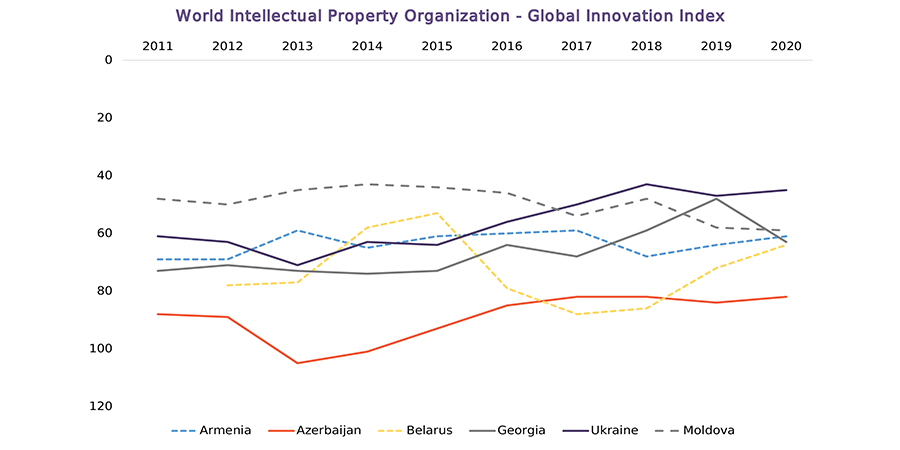
Issue 8: Ukraine in International Rankings
18-May-2021
International rankings and indicators help us to understand and assess how countries are performing in different areas. In this bulletin, Ukraine’s positions in international rankings and the dynamics therein will be reviewed based on recent data. The positions will also be compared with other Eastern Partnership (EaP) countries (Armenia, Azerbaijan, Moldova, Georgia, and Belarus).
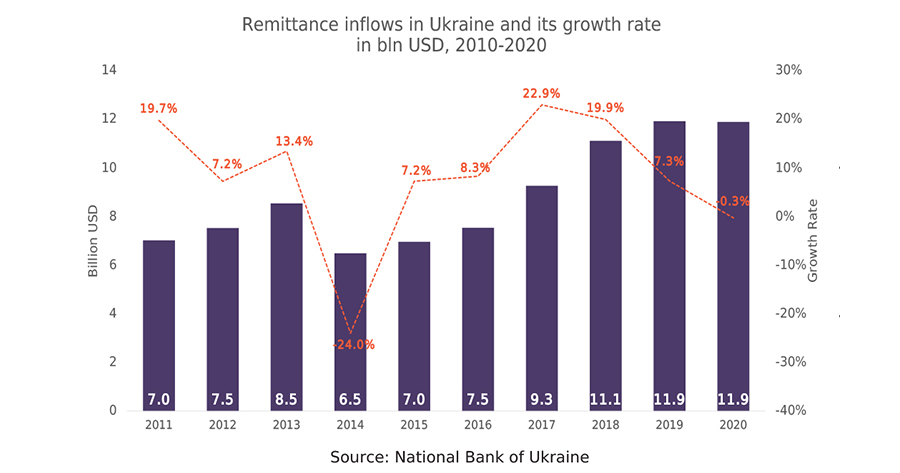
Issue 7: Remittance Inflows into Ukraine
29-Apr-2021
In this bulletin, a snapshot of remittance inflows into Ukraine pre-COVID is discussed, followed by its developments in 2020.
According to the World Bank, global remittances will decline by 14% by the end of 20212, compared to the pre-pandemic level of 2019;
In 2020, remittance inflows into Ukraine declined just by 0.3%, compared to 2019;
Remittance inflows in Ukraine have been growing at an annual average of 8.2% over the past decade;
The contribution of remittances to GDP in Ukraine amounted to 7.7% in 2020;
The top senders of remittances to Ukraine in 2020 were Poland (26%), the United States (10%), and the United Kingdom (9%). In 2016-2019, the top senders were Poland (30%), Russia (12%), and the United States (8%);
Remittances from Russia declined the most in 2020 (-20%), compared to 2019, while the United Kingdom recorded the strongest growth (69%) over the same period.
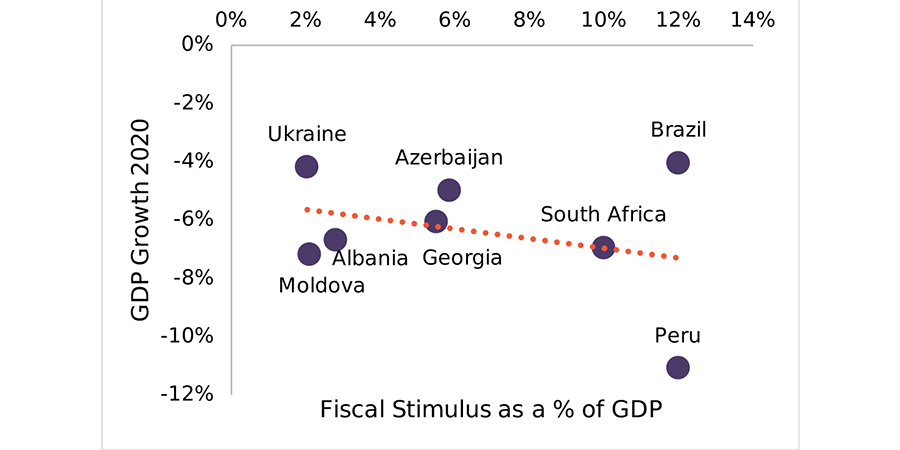
Issue 6: Supporting Businesses During the Pandemic: National and Municipal Responses
29-Mar-2021
To address the challenges posed by the pandemic, various government measures have been taken at both national and local levels. In order to withstand the economic recession, almost all countries, including Ukraine, have introduced significant fiscal stimulus packages. Exclusively for the 2020 fiscal year, the Government of Ukraine created a stand-alone budgetary program under the Ministry of Finance to fight the pandemic, with an overall budget of UAH 80.9 billion (or 2% of Ukraine’s 2019 GDP).
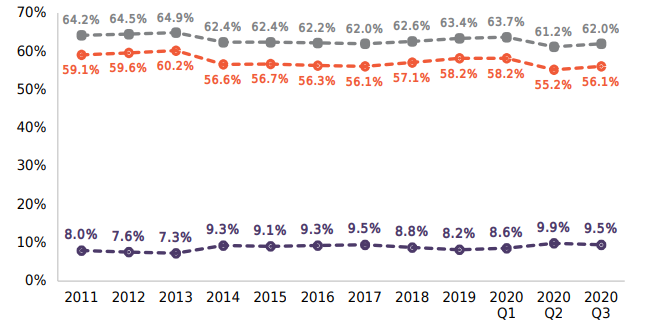
Issue 5: Labor Market in Ukraine
09-Feb-2021
In this issue, we overview trends in Ukraine’s labor market indicators through the past decade and compare the dynamics of unemployment rates of Eastern Partnership countries over the same period. In addition, we analyze the effects of COVID-19 on the key labor market indicators, as well as on average wages and number of vacancies posted in 2020.
- Periodic Issues
- ECONOMIC OUTLOOK AND INDICATORS IN GEORGIA
- HOTEL PRICE INDEX
- PMC RESEARCH - IFO GEORGIAN ECONOMIC CLIMATE
- BLACK SEA BULLETIN
- QUARTERLY TOURISM UPDATE
- ECONOMIC OUTLOOK AND INDICATORS IN UKRAINE
- SECTOR SNAPSHOTS
- EMPLOYMENT TRACKER
- MACRO OVERVIEW
- BAG Index
- Profile Of Bilateral Relations

